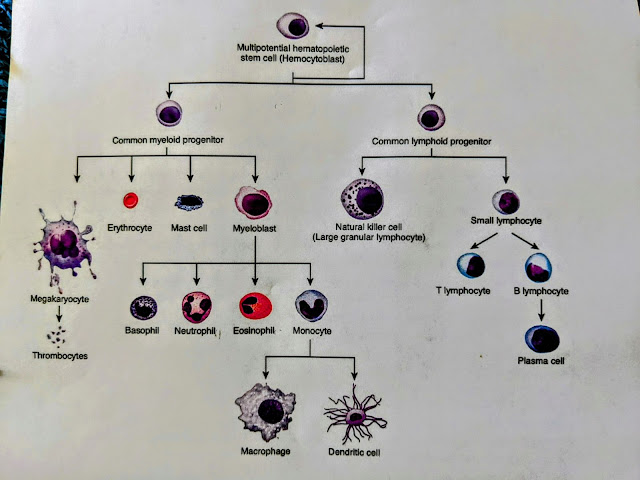So now that the transplant is done, what’s happening. In a word, Haematopoiesis. It’s a Greek word formed from two other Greek words. One meaning ‘blood’ the other meaning ‘to make’. Making blood.
Using stem cells. The ones that, as I type, are being introduced into Kristina.
Fun fact: The healthy
adult human makes between 10 billion and 100 billion new blood cells each day
(no wonder I’m tired). Take a nap. You’ve earned it.
What sorcery is at play?
Stem cells. Haematopoietic stem cells. Or, as my spell checker likes, Hematopoietic stem
cells. These cells have the unique
ability to give rise to all the different mature blood types and tissues. Some that stay in the bone marrow, some that
flow through the blood and others that in tissues. In laymens terms, the main
ones are red blood cells, white blood cells, and the platelets.
But (of course) it’s more complicated than that. Stem cells can create a wide variety of cells,
but do so through another layer of cells called ‘progenitor cells’. The progenitor cells are only slightly less
cool than stem cells.
Stem cells can live indefinitely and create progenitors, but
progenitor cells can only create certain specific cell types and can only
replicate so long before they expire. As
long as the stem cells are good, the creation of the progenitors and subsequent
cell types can go on for a long time.
So what type of cells do stem cells create? They have big fancy words and different
levels of creation. Picture a big family
tree with two diverse kids more diverse grandkids and great grandkids each with
special powers all originating from a single parent (don’t dwell on that analogy
too long). But it’s fascinating how
these stem cells organically know where to go (the spongy bone marrow) and how
they replicate into myeloid progenitors and common lymphoid progenitors which
in turn create another level and type of blood cells, some of which then give
rise to still other types of blood cells.
The progenitors mostly live in the factory – the bone
marrow. But the cells they create go
forth and do the real work throughout the body, delivering oxygen and fighting
off invaders.
And while we’re at it, let’s ponder for a bit just how new
this process of transplanting stem cells is.
It started in the 1950’s, the decade into which I was born, right here
in Seattle by the very hospital where Kristina is getting her transplant – the Fred
Hutch Cancer Research Center (which is now just the Fred Hutch Cancer Center).
Dr. E. Donnall Thomas was the primary driver of treatments
for blood cancers in the 60’s at the Fred Hutch and received the 1990 Nobel Prize
in medicine for his ground breaking research.
Most of which was done right here in Seattle.
Fascinating process and Kristina’s in the right place at the
right time in history.



No comments:
Post a Comment